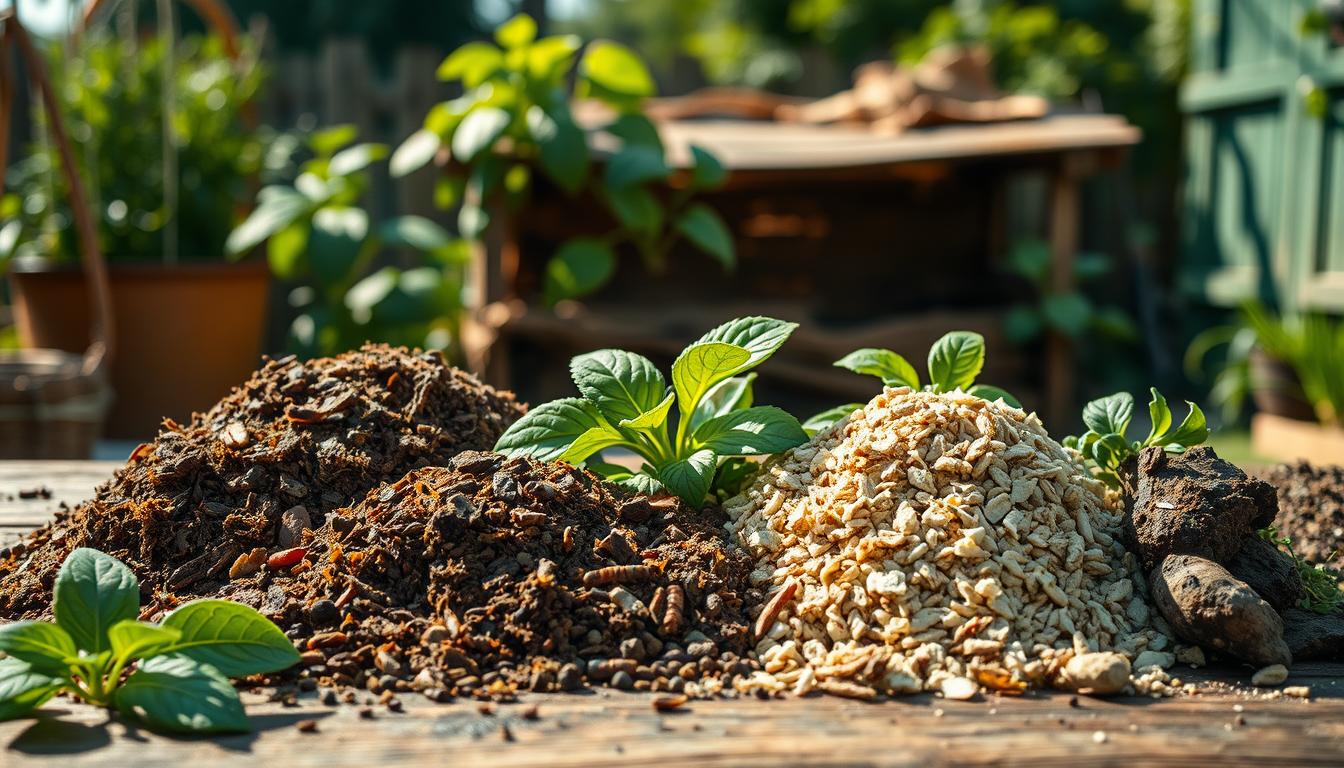Gardening with earth-friendly options is becoming more popular. People are realizing how their choices affect the environment. Using organic soil amendments means you’re not just growing plants. You’re also creating a healthy ecosystem without harsh chemicals.
Chemical products might work fast, but they have hidden downsides. They can harm good soil organisms and pollute waterways. This makes plants need more chemicals to grow, creating a cycle of dependency.
Natural fertilizers are different because they work with soil biology, not against it. They release nutrients slowly, making soil better and supporting plant health from the roots up.
Organic soil amendments are simple yet effective. They’re great for both new and experienced gardeners. Switching to these options makes your garden vibrant and healthy. It’s also good for the planet and makes your plants stronger.
The Growing Need for Sustainable Gardening Practices
Sustainable gardening is now essential, not just a trend. We gardeners know our choices affect the environment. Our methods to feed our plants impact more than just our gardens.
This awareness has led to a big change. Many of us are looking for ways to help our plants and the planet. We want to use methods that are good for both.
Environmental Impact of Conventional Fertilizers
Conventional fertilizers have changed gardening and farming, but they harm the environment. When it rains or we water, these fertilizers pollute our water. This pollution can kill fish and plants in rivers and lakes.
These fertilizers also hurt our soil. They reduce the good bugs and plants in the soil. Making these fertilizers uses a lot of energy, which adds to climate change.
The Shift Toward Organic Gardening Solutions
More people are choosing organic gardening. They want to avoid harmful chemicals in their food. They also want to protect the environment.
Home gardeners are at the forefront of this change. They want safe food and a cleaner planet. They see their gardens as part of a bigger ecosystem.
Switching to natural fertilizers and organic soil takes effort. But the benefits are worth it. We get healthier soil, safer food, and help the planet. Together, we can make a difference for our earth.
What Are Natural Fertilizers and Why Choose Them
Natural fertilizers are made from organic materials that feed your plants and improve soil health. They come from plants, animals, and minerals and are processed less than synthetic fertilizers. These natural options work with nature, making your garden more self-sustaining over time.
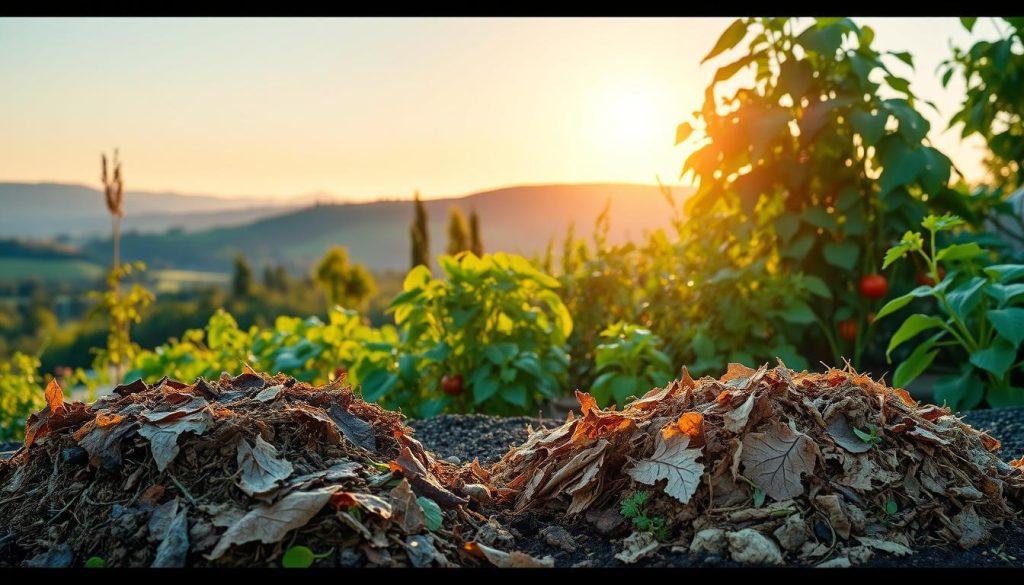
Switching to natural fertilizers can make your plants healthier and your garden more vibrant. These organic options are an investment in your garden’s long-term health.
Defining Characteristics of Organic Amendments
Natural fertilizers differ from synthetic ones in several ways. They have complex nutrient profiles, providing both macronutrients and micronutrients. This helps plants absorb nutrients efficiently.
They also have biological activity. Many organic amendments contain beneficial microorganisms or feed soil life. This creates a living soil web that breaks down nutrients for plants.
Another key feature is their slow release of nutrients. This matches plants’ needs better and prevents nutrient leaching or root burning.
Long-term Soil Health Benefits
Natural fertilizers improve soil quality over time. Each application adds organic matter, enhancing soil structure. This balance helps with water retention and drainage.
Soil with natural fertilizers has more carbon, benefiting the climate and holding nutrients. It also allows roots to grow deeper, accessing more nutrients and water.
This improves soil health, reducing the need for frequent fertilization. It also makes your garden more resilient to environmental stresses.
Environmental Advantages
Using natural fertilizers reduces your garden’s environmental impact. Unlike synthetic fertilizers, they don’t leach into waterways. They stay in the soil, where they belong.
Producing natural fertilizers often requires less energy than synthetic ones. Many, like compost and cover crops, can be made in your garden. This cuts down on transportation emissions.
Perhaps most importantly, natural fertilizers support biodiversity. They feed earthworms, beneficial insects, and soil microbes. This creates a balanced garden environment where pests naturally decrease over time.
Natural Fertilizers vs. Synthetic Options: A Comparison
Choosing between natural and synthetic fertilizers is more than just about quick plant growth. It’s about the health of your soil, the balance of your garden’s ecosystem, and your impact on the environment. Both types give plants the nutrients they need, but they do it in different ways.
Natural fertilizers come from plants, animals, or minerals and are processed lightly. Synthetic fertilizers, made in factories, offer specific nutrient mixes. Knowing the difference helps gardeners choose what fits their gardening style and goals.
Nutrient Release Patterns
Natural fertilizers release nutrients slowly as soil microbes break them down. This slow release matches how plants naturally take in nutrients. Your plants get a steady supply without the risk of burning or losing nutrients.
Synthetic fertilizers, on the other hand, release nutrients quickly. This can give plants a fast growth boost. But, it can also lead to nutrient loss in heavy rains and doesn’t improve soil structure. This can stress plants and make them dependent on constant fertilizing.
Impact on Soil Microbiome
Organic soil amendments are great for soil life. They feed beneficial soil organisms like bacteria and fungi. These creatures help improve soil structure, fight diseases, and help plants get nutrients.
Many synthetic fertilizers have high salt levels that can harm these soil ecosystems. Over time, they can reduce the number of beneficial microbes. This makes the soil less fertile and more dependent on fertilizers to stay healthy.
Cost Considerations Over Time
Synthetic fertilizers might seem cheaper at first because they’re more concentrated. But, they only look at the short-term cost. Natural fertilizers cost more upfront but offer long-term benefits.
Natural fertilizers improve soil structure and water retention. They also boost biological activity. As soil health grows, you’ll need fewer fertilizers, saving money and making your garden more resilient.
Don’t forget the environmental costs of synthetic fertilizers. Making them uses a lot of fossil fuels and adds to greenhouse gases. Water pollution from runoff is another hidden cost.
| FeatureNatural FertilizersSynthetic FertilizersGarden ImpactNutrient ReleaseSlow, steady release over monthsImmediate availability, short durationNatural options provide consistent nutrition without leachingSoil StructureImproves tilth, aeration, and water retentionLittle to no structural improvementBetter soil structure means healthier roots and drought resistanceMicrobiome EffectsFeeds and supports diverse soil lifeMay harm beneficial organismsHealthy soil biology creates disease resistance and nutrient cyclingLong-term CostHigher initial cost, decreasing needs over timeLower upfront cost, consistent ongoing expenseNatural options often prove more economical over multiple seasonsEnvironmental ImpactMinimal processing, low carbon footprintEnergy-intensive production, potential runoff issuesNatural fertilizers align with sustainable gardening practices |
|---|
Compost: The Gardener’s Black Gold
Compost is the gardener’s ‘black gold’ – a treasure made from garden waste. It’s a nutrient-rich substance that turns waste into a valuable soil amendment. This material shows how nature recycles, turning kitchen scraps and yard trimmings into a treasure for plants.
Compost is special because it has a balanced mix of nutrients. Unlike synthetic fertilizers, compost gives plants everything they need. It releases nutrients slowly, giving plants steady nourishment.
Compost also makes soil better. It helps sandy soils hold water and improves drainage in clay soils. This creates a great environment for roots and microbes.
Compost is also good at fighting diseases. Studies show it can resist many common plant diseases. The microbes in compost fight off pathogens and protect plant roots.
Compost helps fight climate change too. By using compost, gardeners can reduce waste and sequester carbon in the soil. This is a small but important step towards a greener future.
Composting is easy and accessible. You don’t need special equipment or knowledge. Nature does most of the work, and all you need is patience.
Creating Your Own Compost System
Starting a compost pile connects you to nature’s cycles. It’s simple, and you can choose the method that fits your needs. The basic ingredients are “browns” and “greens.”
The ideal mix is 3 parts browns to 1 part greens. This mix helps decomposition happen efficiently.
Hot Composting Methods
Hot composting makes compost fast, in just 1-3 months. It needs more attention but gives quick results. A pile of at least 3 feet in each dimension is needed to keep it hot.
Use a compost thermometer to check the temperature. Aim for 130-150°F. Turn the pile weekly to add oxygen and speed up decomposition. Keep it moist, like a wrung-out sponge.
Cold Composting for Beginners
Cold composting is easy and perfect for busy gardeners. Just add materials as you go and let nature do the rest. It takes longer, but it’s low effort.
This method works in wire bins, tumblers, or open piles. Just be patient, and nature will turn waste into compost.
Using Compost Effectively in Different Garden Settings
Compost is versatile and valuable in all gardens. Knowing how to use it effectively is key. It prevents nutrient runoff and maximizes benefits.
Timing is important when applying compost. Spring and fall are the best times. Spring gives nutrients for growth, and fall improves soil structure for the next season.
| Garden Setting | Application Rate | Application Method | Best Timing |
|---|---|---|---|
| Vegetable Gardens | 1-3 inches | Mix into top 6 inches of soil | Early spring and fall |
| Perennial Beds | 1/2-1 inch | Apply as mulch around plants | Early spring or late fall |
| Container Plants | 20-30% by volume | Mix with potting soil | When repotting or refreshing |
| Lawns | 1/4-1/2 inch | Top-dress and rake in | Early spring or early fall |
| Trees and Shrubs | 1-2 inches | Apply as mulch around drip line | Spring or fall |
In vegetable gardens, mix compost into the soil before planting. This helps roots get nutrients right away. For perennials, use compost as a top dressing to avoid disturbing roots.
Container gardens benefit from compost, which helps retain moisture and prevents compaction. Mix 20-30% compost into your potting mix for healthier plants.
Lawns also benefit from compost, applied as a thin top dressing after aeration. This builds soil health and promotes deeper roots and drought resistance without chemicals.
Animal-Based Natural Fertilizers
Animal byproducts are rich in nutrients, making them great natural fertilizers. They’ve been used for centuries to improve soil and grow more crops. While they might seem unusual, their benefits for plants are undeniable. Let’s look at the best animal-based fertilizers and how to use them in your garden.
Manure: Types and Application Methods
Each animal manure has its own nutrient profile and benefits. They are suited for different garden needs.
- Chicken manure – High in nitrogen and phosphorus; great for heavy feeders like corn and leafy greens
- Horse manure – Balanced nutrients with lots of organic matter; good for general garden use
- Cow manure – Lower in nutrients but gentle on plants; perfect for sensitive seedlings
- Rabbit manure – Can be applied fresh without burning plants; ideal for vegetable gardens
Aging and Composting Requirements
Fresh manure has high ammonia levels and can carry pathogens. It must be aged or composted before use. Allow 3-6 months of aging before applying to vegetable gardens.
Composting kills pathogens, removes weed seeds, and makes nutrients plant-friendly. A compost pile should reach 130-150°F for safety.
Application Rates by Garden Type
The amount of manure needed varies by garden type and manure type. Here’s a general guide:
- Vegetable gardens: Apply 1-2 inches of composted manure into the top 6 inches of soil before planting
- Flower beds: Use 1 inch of composted manure worked into soil or as a top dressing
- Trees and shrubs: Apply a 1-inch layer from the trunk to the drip line, avoiding direct contact with stems
Bone Meal for Phosphorus-Rich Soil
Bone meal comes from ground animal bones and is rich in phosphorus and calcium. It promotes strong roots, flowering, and fruiting. It’s great for bulbs, roses, and perennials.
To use bone meal, mix 2-3 tablespoons per square foot into the soil before planting. For established plants, sprinkle around the base and mix into the top soil layer. The nutrients release slowly over 4-6 months.
Be careful with bone meal as it can attract animals. If it attracts dogs or raccoons, cover treated areas with mulch or use a less aromatic phosphorus source.
Guano: A Powerful Nitrogen Source
Bat and seabird guano are very potent natural fertilizers. They are rich in nitrogen, phosphorus, and trace minerals. Bat guano has about 10-12% nitrogen, making it three times more powerful than most manures.
Guano also has beneficial microbes that improve soil health. These microbes help break down organic matter and make nutrients available to plants. This not only feeds your plants but also enhances your soil’s ecosystem.
When using guano, a little goes a long way. For container plants, mix 1-2 tablespoons per gallon of potting soil. In garden beds, apply ¼ to ½ pound per 10 square feet. Many gardeners prefer to brew guano tea by steeping 1 cup in 4 gallons of water for 24-48 hours. Then, use this liquid as a soil drench or foliar spray.
Plant-Based Organic Amendments
The plant world is full of sustainable soil amendments that mimic nature. These organic amendments give plants the nutrients they need. They also improve soil structure and help beneficial microorganisms.
Unlike synthetic fertilizers, these natural options break down slowly. This means they provide long-term benefits without harming the soil.
Green Manures and Cover Crops
Green manures and cover crops are great for boosting soil fertility. Plants like clover, vetch, and buckwheat are grown to be turned back into the soil. This creates a natural way to fertilize.
These plants do more than just add nutrients. Legumes like clover and vetch work with bacteria to capture nitrogen from the air. Their roots also prevent erosion and improve soil structure.
When cut down and added to the soil, these plants release their nutrients slowly. This adds organic matter that improves soil health and supports beneficial microbes.
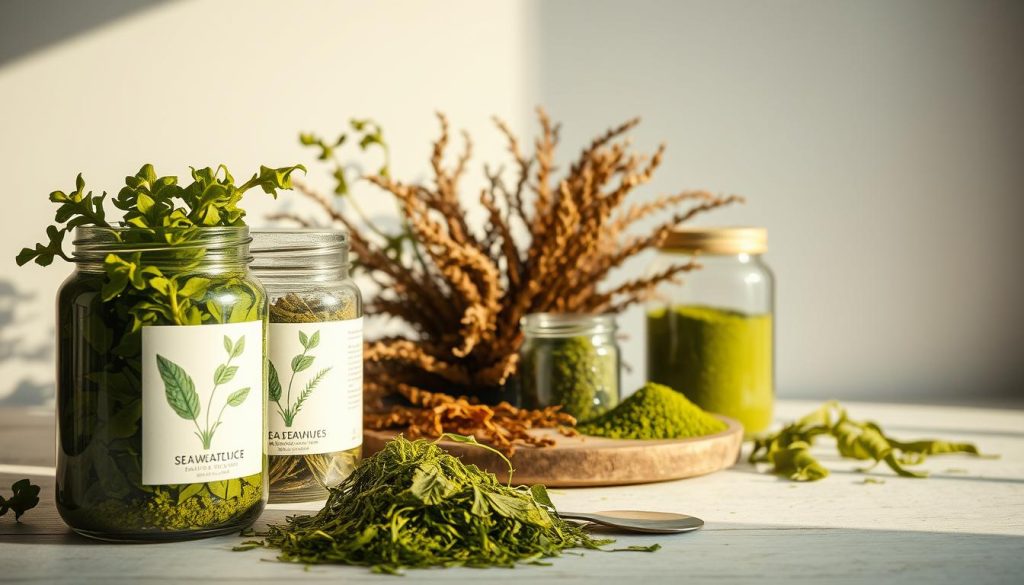
Seaweed Extracts and Their Unique Benefits
Seaweed extracts are special because of their rich nutrient profile. They contain over 60 trace minerals, growth hormones, and complex carbohydrates. These benefits plants in amazing ways.
Unlike many fertilizers, seaweed extracts provide a wide range of micronutrients. They also have natural plant growth regulators. These help plants grow stronger roots, flowers, and fruits.
Seaweed extracts can be used as dried meal or liquid concentrate. They help plants fight off drought, frost, and pests.
Alfalfa and Other Plant-Derived Fertilizers
There’s more to plant-derived fertilizers than green manures and seaweed. Alfalfa meal, made from legume hay, is a balanced fertilizer. It has nitrogen, phosphorus, potassium, and growth stimulants called triacontanol.
Cottonseed meal is great for acid-loving plants like blueberries and azaleas. Soybean meal offers similar benefits with a different nutrient mix. Even plants like comfrey and nettles can be used as nutrient-rich mulches or teas.
These plant-based amendments are sustainable and often locally produced. They reduce your garden’s carbon footprint while improving soil health.
| Plant-Based Amendment | Primary Nutrients | Best Uses | Application Rate |
|---|---|---|---|
| Alfalfa Meal | 2-1-2 NPK | All-purpose fertilizer | 2-5 lbs per 100 sq ft |
| Seaweed Extract | 1-1-2 NPK + micronutrients | Stress resistance, micronutrients | 1-2 tbsp per gallon (liquid) |
| Cottonseed Meal | 6-2-1 NPK | Acid-loving plants | 3-6 lbs per 100 sq ft |
| Soybean Meal | 7-2-1 NPK | Nitrogen boost for heavy feeders | 3-4 lbs per 100 sq ft |
Mineral-Based Natural Fertilizers
There’s more to natural soil amendments than compost and animal byproducts. Mineral-based fertilizers come from the Earth’s crust. They’ve been around for millions of years, offering essential nutrients slowly. This helps build a strong foundation for soil health.
These natural fertilizers work well with soil biology. They connect your garden to the Earth’s ancient processes.
Rock Phosphate for Long-Term Phosphorus Supply
Rock phosphate is a top choice for organic gardeners. It’s a natural source of phosphorus that slowly releases over 5-10 years. This makes it perfect for long-term plantings like fruit trees and perennials.
To use rock phosphate, spread about 10 pounds per 100 square feet for very depleted soils. For maintenance, use 2-5 pounds. Mix the fine powder into the soil before planting. It works best in neutral to alkaline conditions, so adding slightly acidic amendments like compost can help.
For best results, mix rock phosphate with mycorrhizal fungi. These fungi help plants absorb phosphorus in exchange for sugars. It’s a natural way for plants and fungi to work together.
Greensand and Its Multi-Nutrient Profile
Greensand is a blue-green marine sediment from millions of years ago. It’s packed with potassium, iron, magnesium, calcium, and over 30 trace minerals. These nutrients are vital for plant health and growth.
Greensand also improves soil structure. Its unique structure helps sandy soils hold moisture and improves drainage in clay soils. This makes it useful for almost any soil type.
Use greensand at 5-10 pounds per 100 square feet, mixing it into the top 6 inches of soil. Its nutrients release slowly, but it improves soil structure right away. Many gardeners find their soils better and need less water.
Volcanic Rock Dust for Trace Minerals
Volcanic rock dust is nature’s way to remineralize soil. It’s made from finely ground materials from mining, packed with trace elements. These elements are often missing in intensively farmed soils.
Soils with volcanic rock dust show better disease resistance and stronger plant growth. This is because trace minerals like manganese and zinc are essential for plants.
Apply volcanic rock dust at 2-4 pounds per 100 square feet each year. You can broadcast it or add it to compost. It’s like vitamin supplementation for your soil, filling in gaps that regular fertilizers might miss.
Biological Soil Enhancers
Biological soil enhancers turn ordinary soil into a living, growing environment. They don’t just add nutrients like traditional fertilizers. Instead, they support the complex life beneath our feet.
By using these enhancers, you’re not just feeding your plants. You’re creating a whole ecosystem that works with them.
Mycorrhizal Fungi: Nature’s Root Enhancers
Mycorrhizal fungi are a remarkable partnership in nature. They form relationships with plant roots, extending the root system up to 700 times. This helps plants get more water and nutrients, even in tough soil.
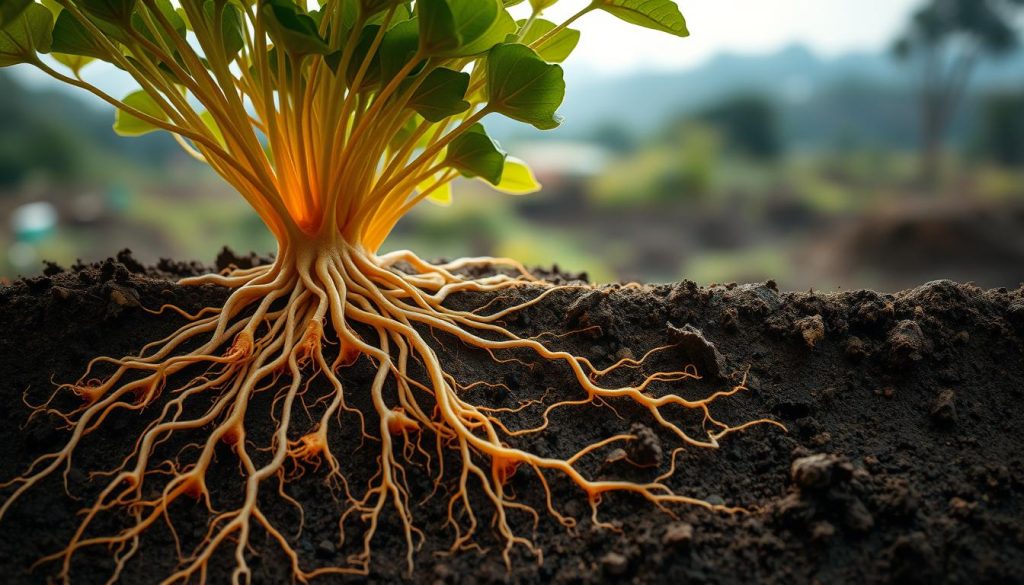
To add mycorrhizal fungi to your garden, timing is key. Apply them directly to roots when planting for the best results. For existing plants, make small holes near the drip line and add the fungi.
Not all plants benefit the same from mycorrhizal fungi. The biggest improvements are seen in:
- Trees and woody shrubs
- Most vegetables (like onions and carrots)
- Perennial flowers
- Drought-stressed plants
- Plants in poor or compacted soil
Beneficial Bacteria for Nutrient Cycling
Beneficial bacteria act as tiny nutrient factories in your soil. They do things that chemical fertilizers can’t. Some bacteria turn nitrogen from the air into a form plants can use. Others release phosphorus, making it available to plants.
Compost tea is a great way to add beneficial bacteria to your garden. It’s made by brewing microorganisms from quality compost. Commercial bacterial inoculants are another option, with blends for different plants and conditions.
To support your soil’s bacteria, use organic practices. Avoid synthetic pesticides and fertilizers. Keep soil moist, add organic matter, and avoid tilling.
Healthy garden soil has billions of microorganisms per teaspoon. These tiny helpers break down organic matter, improve soil structure, and help plants fight diseases. By caring for these underground workers, you create a self-sustaining system that gets stronger each season.
Creating a Natural Fertilization Plan for Your Garden
A natural fertilization plan is like a roadmap for your garden’s growth. It ensures your plants get the nutrients they need when they need them. This approach also helps build strong soil over time.
Organic gardening works best when you follow nature’s cycles. By timing your fertilizers with the seasons, you get the most out of your soil. This way, you also reduce waste and protect the environment.
Seasonal Application Guidelines
When you apply natural fertilizers is just as important as what you use. Each season has its own needs for your garden soil.
Spring Preparations
In spring, plants need nutrients to grow. Here are some early steps:
- Apply quick-release fertilizers like worm castings or compost 2-3 weeks before planting
- Use fish emulsion or compost tea as liquid feeds for new plants
- Spread light amounts of balanced organic fertilizers in beds
- Put mulch on to keep moisture and slowly feed the soil as it gets warmer
Fall Soil Building
Fall is a time for renewal and soil preparation. It’s perfect for building soil for next year:
- Add slow-release amendments like bone meal and rock phosphate that break down over winter
- Use lots of organic matter like leaf mulch and compost
- Plant cover crops like clover or winter rye to protect and feed the soil
- Apply mineral amendments that need time to mix with soil biology
Matching Fertilizers to Plant Needs
Each plant needs different nutrients. Knowing these needs helps you use fertilizers wisely and save money.
Plants like tomatoes, corn, and squash need a lot of nitrogen. Use composted manure, blood meal, or fish emulsion for them. They need regular feeding to grow well.
Herbs, beans, and peas need less fertilizer. A good compost base at planting time is enough. Too much fertilizer can harm their taste or growth.
Plants like blueberries, azaleas, and rhododendrons need acidic soil. Use pine needle mulch, cottonseed meal, or acidic compost for them. They don’t do well in alkaline soil.
Combining Different Natural Fertilizers for Maximum Benefit
Using different fertilizers together can be very effective. This mix provides all the nutrients plants need and improves soil health.
Here are some good combinations:
- Compost + rock minerals: Compost makes minerals easier for plants to use
- Manure + bone meal: This mix balances nitrogen and phosphorus for plants to bloom and fruit
- Seaweed extract + worm castings: Adds micronutrients and beneficial microbes
- Cover crops + compost tea: Builds soil structure and boosts microbes
Observation is key in making your fertilization plan. Watch how your plants react to different fertilizers and adjust as needed. Natural fertilizers are gentle and rarely cause problems.
As you get more experience, you’ll know what your garden needs and when. Your fertilization plan will become more flexible, adapting to your garden’s changing needs through the seasons.
Common Challenges and Solutions When Using Natural Fertilizers
Natural fertilizers have many benefits but also face common challenges. These challenges have simple solutions that keep your garden organic. With the right planning, you can overcome these issues and enjoy the benefits of natural fertilizers.
Addressing Slower Nutrient Release
Switching to natural fertilizers means adjusting to slower nutrient release. Unlike synthetic fertilizers, organic amendments take time to break down and release nutrients.
To speed up, use quick-acting natural options like compost tea. It provides nutrients fast. Fish emulsion and worm castings also release nutrients quickly while staying organic.
Start treating your soil weeks before planting to give natural fertilizers a head start. For gardens switching from synthetic fertilizers, a gradual transition helps plants adjust.
Managing Odors and Other Practical Concerns
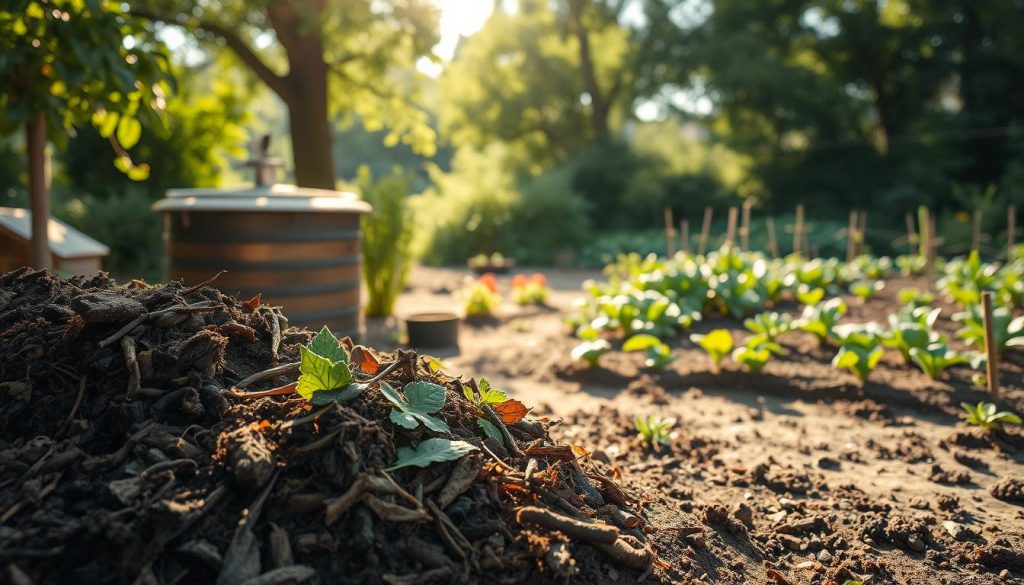
Some natural fertilizers, like fish emulsion, can smell bad. To reduce odors, mix them into the soil right away. Then, add mulch to trap smells and speed up decomposition.
Store natural fertilizers in airtight containers away from living areas. Many products are now deodorized, keeping smells down without losing effectiveness.
When applying messy fertilizers, use a fork or trowel, not your hands. Wear gloves and old clothes. Water well after to help break down the amendments and cut down on odors.
Troubleshooting Nutrient Deficiencies
Even with natural fertilizers, plants might show nutrient deficiencies. Yellow leaves often mean nitrogen shortage. Purple leaves suggest phosphorus issues. Brown edges mean potassium problems.
For quick nitrogen, use diluted fish emulsion or compost tea as a spray. Bone meal is a fast phosphorus source. Wood ash can fix potassium issues quickly.
Soil testing is key to catch problems early. Adjust your fertilization plan based on test results. Some issues might be pH problems, not nutrient deficiencies.
| Common Challenge | Quick Solution | Long-term Strategy | Best Natural Fertilizers to Use |
|---|---|---|---|
| Slow nutrient release | Apply compost tea or fish emulsion | Build soil organic matter over time | Worm castings, composted manure |
| Unpleasant odors | Incorporate amendments into soil immediately | Use deodorized commercial products | Aged compost, alfalfa meal |
| Nitrogen deficiency | Foliar spray with fish emulsion | Add leguminous cover crops to rotation | Blood meal, chicken manure |
| Phosphorus shortage | Apply bone meal or rock phosphate | Maintain proper soil pH (6.0-7.0) | Bone meal, fish bone meal |
| Potassium deficiency | Add wood ash (sparingly) | Incorporate compost with banana peels | Greensand, kelp meal |
Your Path to a Thriving, Naturally Fertilized Garden
Starting with natural fertilizers doesn’t have to be hard. Many gardeners start small, like with a compost bin or organic soil in one bed. These small steps lead to big changes and confidence.
Switching to natural fertilizers does more than just help your garden. It gives your plants the nutrients they need for strong roots and better health. The soil becomes better at holding water and supports a healthy ecosystem. Every bit of compost or bone meal connects you to a long tradition of sustainable gardening.
Natural fertilizers work with nature, not against it. They don’t harm waterways like synthetic fertilizers can. Instead, they nourish your plants and improve the soil over time. This creates a cycle of health: better soil means healthier plants that need less help.
Choosing natural fertilizers makes your garden a lasting legacy. The soil you improve today will help your plants for years. Whether you grow veggies, flowers, or a lawn, natural gardening leads to vibrant growth and protects our planet.
Start your natural gardening journey today. Your plants, soil, and the planet will all be grateful.

